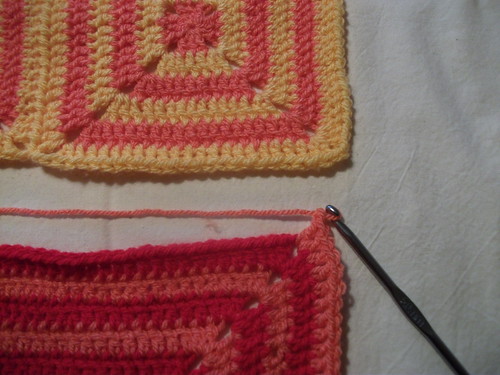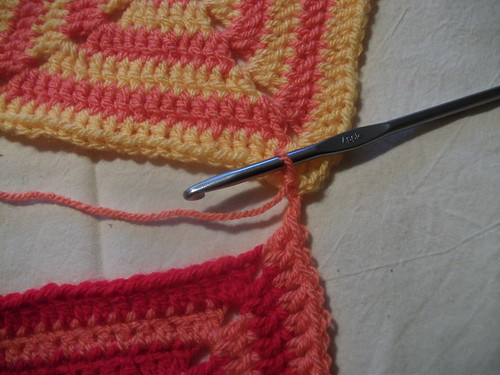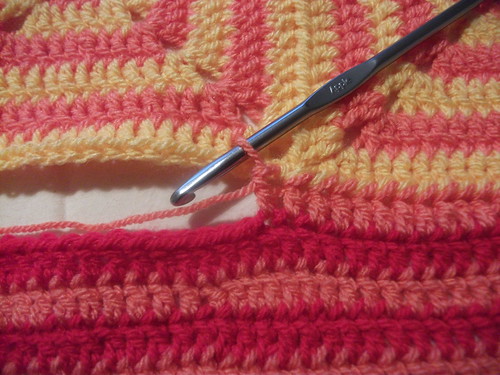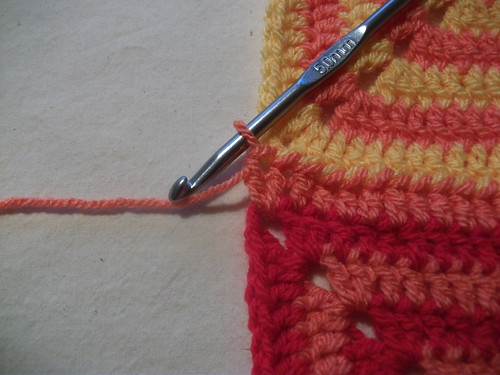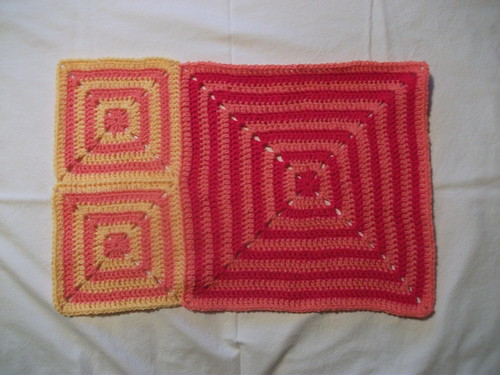Shortly after I first learned to knit I discovered people talking about hand knitting socks. For some reason this appeals to me, having a drawer full of pretty colourful socks. I also figured that socks were a short term project, which considering most of my projects are huge, would be a nice change. So I figured I had best do some research.
Where to Start?
It seems there are three (main) ways to knit small diameter tubes; double pointed needles (DPN's), 2 circular needles, magic loop (ML). Around the time I was doing the research to figure out what I was doing it became clear my daughter didn't like mittens and the shops don't sell gloves with fingers for such small hands. As a result I made some basic crochet mittens, these worked as she keeps them on. However they were made with no stretch in them and were hard to get on. So I figured a small pair of fingerless gloves were a good place to practice the three methods of knitting small tubes. The idea is to knit a small tube in a 2x2 rib and make a one row buttonhole for the thumb.
Two Circular Needes
So with some scrap yarn I started with the 2 circs method as that was the easiest place to start. I found I could do this and also found I had no ladders! This was a great start but I found I didn't like the various needles hanging down as I worked. Don't get me wrong, that's only a minor complaint. What was good for me is that I found I have a tendency since getting circular needles to drop the empty needle as its normally attached and hard to lose. This is OK until you switch back to straights or as next DPN's
DPN's - or Sticks if you are my husband
In the meantime I had bought a set of DPN's so I tried them, but had various problems with them. I can knit with them, but found I had to constantly move them and adjust them just so I could knit. It turns out the way I purl doesn't work with the DPN's as every time I tried to purl my working yarn got caught in one of the tips of the DPN's. I was kind of upset by this as for some reason I really wanted to use DPN's, don't know why. Also because of my tendency to drop empty needles when not in use (using circs this isn't a problem as they are attached to each other) meant I kept dropping a dpn and had to chase it. Although I wanted to like DPN's I found I had lots of big ladders no matter what I did, this was disappointing as with 2 circs I had to put in little effort to avoiding ladders.
Magic Loop
So yesterday I tried the last method, magic loop, I like this. It doesn't result in anything hanging down to annoy me, theres no chance of losing a needle as with DPN's. Another bonus was that there were no ladders, OK so getting the stitches back onto the needle was often tight but not impossible.
So Now what?
For some reason I keep wanting to like DPN's, I cant figure out why I want to either. In the end having tried several times to get the DPN's to work for my I had to be sensible and say it just wasn't working. So that leaves either 2 cirs or magic loop, which isn't a contest in my mind now. The thing is the way the stitches are configured on both those methods is identical and ML has the advantage of using only one needle. So I reckon unless something major happens I will be using magic loop from here on.
As I result of my various tests I now have two fingerless gloves in progress, one on ML and the other on 2 circs. This has proved to be a good comparison and helped me make the choice of ML. In the meantime I will finish both gloves and then start practicing some sock knitting as Santa got a me a book for Christmas.
So now I need to figure out what length of needle I want for ML knitting and buy a set of the smaller sizes for whn I get into sock knitting seriously. The other thing ML has going for it is that you can knit 2 things at the same time on the one needle (if its got a long enough cable). You can do this with 2 circs as well but im not going down that road.
So where am I now? Finish those gloves for the Wench then wth some scrap DK yarn and my 4 mm circs practice making a sock. I decided this first attempt isn't going to be made to fit anyone but just me getting the hang of making a sock without worrying about gauge or sock yarn or anything like that (also means I don't have to worry about making a second sock to match).
Have Fun!
I'm a quilter, a crocheter and a knitter as well as a mum to my little wench!
Thursday 30 December 2010
Tuesday 28 December 2010
Joining Squares Part One - Joining Two Same Size Squares Together
This tutorial (hopefully) should show you how to join two same size squares together as in the picture above. This was done Join As You Go (JAYG) style whilst making the last round of the blue square. It looks very neat and tidy, is a strong looking join, uses no extra yarn and as such has no extra ends to weave in. Once you get the hang of this method there is little extra work involved, the only disadvantage I can see so far is that you need to plan your yarn colours ahead of time. As a result of me wanting to make sure every detail was covered I have ended up adding a lot of text to this tutorial, so I recommend you read through all of it at least once first.
So lets begin, these squares are 2 rounds big and are a standard crochet in the round square which has 7 Double Crochet (DC - US terminology) on each side, the corners are 2 DC, chain 2, 2 DC . I began by making the yellow square and finished it by weaving the ends in.
Before we continue I'm going to add some stitch markers to the yellow square to help guide you where we will be going. In each corner there are two chains, when joining two squares together we will be joining one chain from each corner. So in the picture below the green marker is in the right chain of the right hand corner and the black marker is in the left chain of the left corner. This should leave (as the picture is trying to illustrate) 1 chain, 7 DC, 1 chain, between the two stitch markers. When we come to join the next square we will begin by joining the chain next the the green marker, then each of the DC's in turn, working towards the black marker, ending up by joining the chain next to the black marker. I hope that makes sense, I have taken a few pictures to try to help. I'm going to apologise now as I bite my nails, I did try to keep them out of the pictures but I failed now and then.
 | ||||||||
| Picture 1. Showing placement of stitch markers |
 |
| Picture 2. Second Square ready to begin the join |
So, as we want the next chain, which we are about to make, joined to the chain to the left of the green stitch marker, we need to join the working loop to that chain on the yellow square. For now that means removing your hook from the working loop, lengthen the loop first though so you don't lose it. Then insert your hook down through the chain situated to the left of the green marker. You are going from the right side towards the wrong side, through both top loops of the chain (this is as though you were making a stitch into it).
 |
| Picture 3. Showing hook placement in chain located next to green marker |
Now that you have inserted the hook, put the working yarn back onto the hook and pull it through the chain of the yellow square.
A quick word about how I'm holding things as I work, I normally hold the two squares being used wrong sides together with the right side of the square I'm currently making towards me. However for taking photos I found I didn't have enough arms to hold the work, the yarn, the hook and the camera. So as a result the pictures are often laid out onto the table so I can take the picture.
This next picture shows the working loop pulled through the chain, the picture on the left is how I generally hold the work (wrong sides together) but the right picture is generally how the photos will look. Both pictures show the same thing happening, the loop has been connected to the yellow square, just the perspective has changed. However on the picture on the left my thumb is tucked behind the bluebell square as I bite my nails I wanted to hide it.
 |
| Picture 4. Showing the working loop connected to the yellow square |
 |
| Picture 5. Showing one connected chain made |
 |
| Picture 6. To the left, the loop connected. To the right, first DC made |
 | |
| Picture 7. To the left, loop is connected to 2nd DC. To the right, 2nd DC made |
 |
| Picture 8. To the left loop connected to 3rd DC, to the right the 3rd DC made |
The next picture show this process repeated for the 4th DC. Remember to follow the process as before, remove your hook from the working loop, insert hook through the 4th DC on the yellow square, pull the working loop through, make DC into the 2nd DC on the bluebell square.
 |
| Picture 9. To the left the loop is connected to 4th DC, to the right the 4th DC made. |
 |
| Picture 10. To the left the loop connected to the 5th DC, to the right the 5th DC made. |
The next DC on the bluebell square is made into the corner space, as before, remove your hook from the working loop, insert hook through the 6th DC on the yellow square, pull the working loop through, make DC into the corner space on the bluebell square.
 |
| Picture 11. To the left the loop connected to the 6th DC and to the right the 6th DC made |
The last DC on the bluebell square is made into the corner space, as before, remove your hook from the working loop, insert hook through the 7th DC on the yellow square, pull the working loop through, make DC into the corner space on the bluebell square.
 |
| Picture12. To the left the loop connected to the 7th DC, to the right the 7th DC made. |
 |
| Picture 13. Showing hook placement for connecting the loop to the chain |
Now the loop is connected as shown above you need to pull the working loop through and then chain 2, the first chain counts as the connected chain and the second chain counts as an unconnected chain as we didn't stop to connect the loop prior to making it.
 |
| Picture 14. showing loop connected to corner chain, and to the right 2 chains made. |
That's the last of the join, from here on you continue to make the bluebell square as normal, complete the corner by making 2 standard DC's into the corner space and continue around to finish the square. The last picture below shows both the front and back of the completed join.
 |
| Picture 15. Completed join front and back. |
Something else I realised, once you go away and come back to something joined this way you can't tell which square was joined first. The way the join is made makes is very hard to tell, unlike other joins which can leave a ridge which tells you which was connected first.
The next part of this tutorial will show how to add a 3rd square below the bluebell one with a view to adding a fourth square to make a square composed of 4 smaller squares.
Back to Joining Index
Monday 27 December 2010
Babette Construction - Section One and Two
Right then, lets get started. I figured that as section one only has one square in it that the first part of this will be both section one and two together. So I will start by listing the squares by the identifying numbers from the pattern and the colours I will be using
The Squares
12-1 uses Matador and Shrimp
6-7 and 6-8 use Shrimp and Saffron
Construction Note
A quick note about construction, I'm using the same style of square from the pattern and my colour chart (shown here) indicates I will be changing colour every round. I start my squares using a magic adjustable ring and use my earlier blog entry to join the squares together, here.
Construction Order
Before I go ahead and get started I'm going to check out the pattern and see if there's a nice neat sequence I can use to join the squares together. At the moment this is easy to decide as we haven't started yet, so let me try to explain what I decided and why.
I could make 12-1 first then attach 6-7 and finally 6-8, however that would mean that 6-8 would have to be "set in" to a corner. While joining into a corner isn't harder, as I'm new to this I want to try and keep the early joins straightforward. So what I'm going to do is join 6-7 and 6-8 together first and then attach 12-1 to the side of them
The First Join
The joining is done on the last round of the squares, so for now I'm going to start by making each square to one round less than they are supposed to be. At that point I'm going to take the time to weave in any tail ends as the last thing I want is to have all my ends to weave in later as I know I will have a lot of them. We are using Part 1 of my tutorials for this join.
The first picture shows me ready to start my join, in the corner I've done 2 DC and 1 chain.
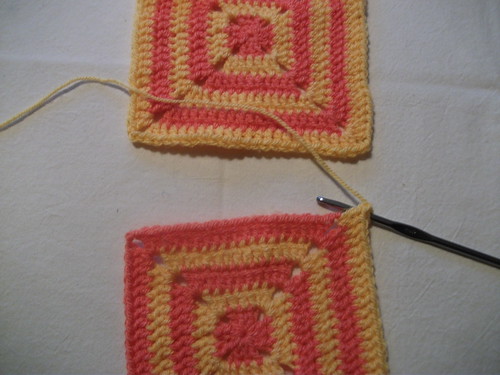
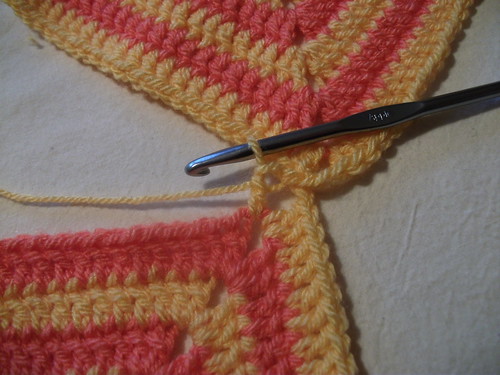
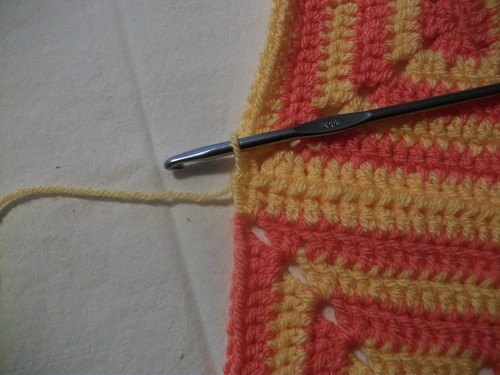
The end of the join, the 2 chains.
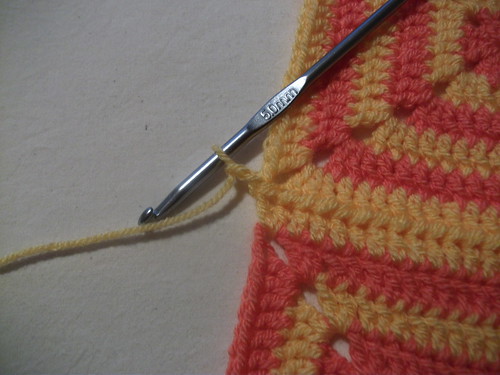

The end of the join, the 2 chains.
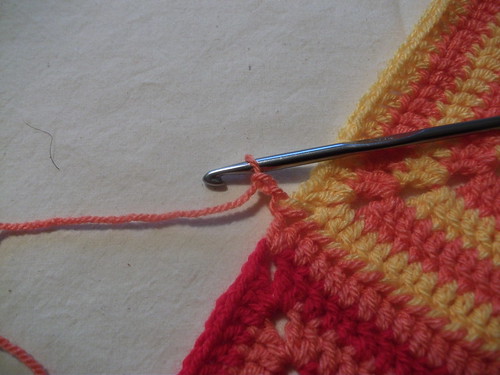
I love the way the orange when next to the yellow looks very orange but when next to the red it looks like a salmon pink. I am really enjoying making this so far, the joining method is making it fun. I love the way the join looks when there are 2 colours as its easy to do :)
Have Fun!
The Squares
12-1 uses Matador and Shrimp
6-7 and 6-8 use Shrimp and Saffron
Construction Note
A quick note about construction, I'm using the same style of square from the pattern and my colour chart (shown here) indicates I will be changing colour every round. I start my squares using a magic adjustable ring and use my earlier blog entry to join the squares together, here.
Construction Order
Before I go ahead and get started I'm going to check out the pattern and see if there's a nice neat sequence I can use to join the squares together. At the moment this is easy to decide as we haven't started yet, so let me try to explain what I decided and why.
I could make 12-1 first then attach 6-7 and finally 6-8, however that would mean that 6-8 would have to be "set in" to a corner. While joining into a corner isn't harder, as I'm new to this I want to try and keep the early joins straightforward. So what I'm going to do is join 6-7 and 6-8 together first and then attach 12-1 to the side of them
The First Join
The joining is done on the last round of the squares, so for now I'm going to start by making each square to one round less than they are supposed to be. At that point I'm going to take the time to weave in any tail ends as the last thing I want is to have all my ends to weave in later as I know I will have a lot of them. We are using Part 1 of my tutorials for this join.
The first picture shows me ready to start my join, in the corner I've done 2 DC and 1 chain.

The next picture shows the first chain joined and made.
Heres the first DC joined and made. Continue on from here, joining each DC in turn.

The last DC joined and made.


Now, the last picture, this shows the join completed, there are 23 DC on the side of these squares.

Adding 12.1
Next I need to join 12.1 onto the side of this piece, 12.1 has 47 stitches on one side. To verify that the join will fit here's the maths, 23 multiplied by 2 is 46, add in 1 for the seam, equals 47 (the number of stitches on the side of 12.1). The picture below show me ready to begin my join. I used Part 4 of my joining series to add this square.
The next picture shows the first chain joined and made.
Here's the first DC joined and made. Continue on from here, joining each of the next 22 DC in turn so you have 23 DC joined and made.
Here we have 23 DC joined and made, the loop just prior to making the 24th DC has been joined through the free corner chains of the other two squares.
Now we have made the 24th DC and can continue to join the remaining 23 DC to 6.8.
The last DC joined and made.
The end of the join, the 2 chains.

Now, the last picture, this shows the join completed.
I love the way the orange when next to the yellow looks very orange but when next to the red it looks like a salmon pink. I am really enjoying making this so far, the joining method is making it fun. I love the way the join looks when there are 2 colours as its easy to do :)
Have Fun!
Babette Construction - How To Join Squares Together
Right, the way I'm joining my squares together is something I un-invented awhile back but didn't have time to properly explore. So I have been trying it out again and came up with a way to join the squares together as a Join As You Go (JAYG) method. I like this because I have no extra ends to weave in, there's little extra work and it doesn't add extra width to the pieces (this is really important with the Babette), however the join looks awesome and very neat.
Since writing my first tutorial it became clear I hadn't included enough detail so I have re-written it for more clear instructions. The first part goes into a lot more detail about the joining and as such its a good idea to read it through before the others.
IMPORTANT NOTES
The later tutorials do not include as much detail in places as the earlier ones. It is hoped that by the time you get to part 3 onwards that you can make joins from part 1 without the detailed explanation.
US Terminology throughout.
Part One - Joining Two Same Size Squares Together
Since writing my first tutorial it became clear I hadn't included enough detail so I have re-written it for more clear instructions. The first part goes into a lot more detail about the joining and as such its a good idea to read it through before the others.
IMPORTANT NOTES
The later tutorials do not include as much detail in places as the earlier ones. It is hoped that by the time you get to part 3 onwards that you can make joins from part 1 without the detailed explanation.
US Terminology throughout.
Part One - Joining Two Same Size Squares Together
In this picture we are adding the red square. There are less pictures than in earlier parts but you should hopefully have the hang if it by now :)
This is the same style of join as Part 4 covers, but from the other direction.Granny Style Squares.
These are dealt with pretty much the same as the other joins, begin with the chain in the corner and join each stitch (or chain) to its opposite ending with a chain at the end. Its just in this case you are sometimes joining chains to chains and DC's to DC's.
Friday 17 December 2010
Babette Construction - Introduction
I'm going to be making a Babette Blanket but using a Join As You Go method I've written about previously. Theres a Crochet A-Long (CAL) on Ravelry that I'm joining in with and some people there expressed interest in what I'm trying to do. As a result I'm going to keep a record here of what I'm doing and try to explain how I'm doing it so that others can do the same if they wish.
The disadvantage of the Babette that puts most people off is usually the many ends to weave in as well as having to seam all those squares together. While the number of ends can depend on how often you change colours, my method of joining does not add to this number and doesn't use much extra yarn (to me its seems I'm using no extra yarn).
So lets get on with the yarn I'm using, which is Stylecraft Special DK. This is an acrylic yarn, double knit weight which is cheap and very soft (unlike some acrylics I've seen). Having some some swatches recently I found I needed to use a 5mm hook for this (I just hope my gauge doesn't change).
Something I realised from reading the forums on Ravelry was that some people found that their smallest squares were too large in proportion to the others and meant the squares did not fit together as they were supposed to. There are a couple of fixes for this, you could make the smaller squares with Half Double Crochets(HDC's) instead of Double Crochets (DC's) or use a smaller hook for those small squares only. Just to clarify I'm talking about the two round squares only, you shouldn't need to adjust any other size square.
When I first swatched for a Babette I seamed my squares together and found that the smallest squares were too big and needed adjustment. It was trying to fix this that stopped me from starting my project and in the end I gave up. It was while swatching with the joining method I'm now using that I noticed my joining method seemed to improve the fit to the point that I didn't need to make any adjustments to the smaller squares at all. I'm assuming that the fit problem was due to the seams adding extra width which in something this large would cause problems.
So for now here's a picture of my yarn and another picture showing my layout coloured in with an extra section I designed myself (I wanted a rectangle not a square).
Have Fun!
Julie
The disadvantage of the Babette that puts most people off is usually the many ends to weave in as well as having to seam all those squares together. While the number of ends can depend on how often you change colours, my method of joining does not add to this number and doesn't use much extra yarn (to me its seems I'm using no extra yarn).
So lets get on with the yarn I'm using, which is Stylecraft Special DK. This is an acrylic yarn, double knit weight which is cheap and very soft (unlike some acrylics I've seen). Having some some swatches recently I found I needed to use a 5mm hook for this (I just hope my gauge doesn't change).
Something I realised from reading the forums on Ravelry was that some people found that their smallest squares were too large in proportion to the others and meant the squares did not fit together as they were supposed to. There are a couple of fixes for this, you could make the smaller squares with Half Double Crochets(HDC's) instead of Double Crochets (DC's) or use a smaller hook for those small squares only. Just to clarify I'm talking about the two round squares only, you shouldn't need to adjust any other size square.
When I first swatched for a Babette I seamed my squares together and found that the smallest squares were too big and needed adjustment. It was trying to fix this that stopped me from starting my project and in the end I gave up. It was while swatching with the joining method I'm now using that I noticed my joining method seemed to improve the fit to the point that I didn't need to make any adjustments to the smaller squares at all. I'm assuming that the fit problem was due to the seams adding extra width which in something this large would cause problems.
So for now here's a picture of my yarn and another picture showing my layout coloured in with an extra section I designed myself (I wanted a rectangle not a square).
Have Fun!
Julie
Thursday 16 December 2010
Christmas Prezzies and Circular Knitting
Right, my in-laws sent us money so that we could buy our own stuff for Christmas this year so I bought some Knitpro stuff.
In an earlier post I wrote about my new Knitpro Interchangeable knitting needles and how i didn't like the acrylic, well I changed my mind. I have a tendency to do this, its normal and quite often end up back where I started. So having decided earlier that I didn't mind the acrylic needles after all I went ahead with my money and bought the deluxe set from Knitpro, the multicoloured set that is!
Along with this I bought some spare cables, cable connectors and one set of 4 mm 6 inch Double Pointed Needles (DPN's). The thing is I've been toying with knitting in the round for a while now, there are 3 ways to do this so I decided to try out all 3 before committing myself to buying lots of extra needles etc. There's magic loop, 2 circular needles and DPN's, my starter set that I already have allowed me to try out the first 2. I found magic Loop do-able but didn't like it, can't put my finger on it though. Using 2 circulars at once to knit a tube worked but I found stopping at the end of each needle to move the stitches onto and off the cables slowed me down. I also found that when it came to putting the stitches back onto the needle from the cable that the last 2 stitches were quite tight and made it harder to do so. I reckon this was a result of me tightening stitches to avoid ladders but couldn't figure out how to stop it happening.
So today I got my first set of DPN's and cast on to try a sample, the first few rounds were a bit fiddly but after a couple of complete rounds it was ok and I way flying, I love these. Don't get me wrong, I could use 2 circulars to knit in the round but I really really love DPN's.
So my next step now that I've figured out how which method I prefer is to buy a set of DPN's, Knitpro do a set in metal and wood
In an earlier post I wrote about my new Knitpro Interchangeable knitting needles and how i didn't like the acrylic, well I changed my mind. I have a tendency to do this, its normal and quite often end up back where I started. So having decided earlier that I didn't mind the acrylic needles after all I went ahead with my money and bought the deluxe set from Knitpro, the multicoloured set that is!
Along with this I bought some spare cables, cable connectors and one set of 4 mm 6 inch Double Pointed Needles (DPN's). The thing is I've been toying with knitting in the round for a while now, there are 3 ways to do this so I decided to try out all 3 before committing myself to buying lots of extra needles etc. There's magic loop, 2 circular needles and DPN's, my starter set that I already have allowed me to try out the first 2. I found magic Loop do-able but didn't like it, can't put my finger on it though. Using 2 circulars at once to knit a tube worked but I found stopping at the end of each needle to move the stitches onto and off the cables slowed me down. I also found that when it came to putting the stitches back onto the needle from the cable that the last 2 stitches were quite tight and made it harder to do so. I reckon this was a result of me tightening stitches to avoid ladders but couldn't figure out how to stop it happening.
So today I got my first set of DPN's and cast on to try a sample, the first few rounds were a bit fiddly but after a couple of complete rounds it was ok and I way flying, I love these. Don't get me wrong, I could use 2 circulars to knit in the round but I really really love DPN's.
So my next step now that I've figured out how which method I prefer is to buy a set of DPN's, Knitpro do a set in metal and wood
Monday 13 December 2010
Update on Babette
Right, if I recall correctly my last thoughts on this was to use Biggan Merino to get the colours I wanted. This has changed considerably, mostly due to the price of the yarn, at £5 a ball it was going to cost a lot of money.
Also I had been swatching up to test my gauge for this project and ran into some troubles. It seems that the smallest squares in the pattern can often be too big to fit correctly in some areas. It was this size issue that made me swatch, and I'm glad I did as mine were too big as well. I tried a few different ways to re size my little squares but ended up unhappy about it and the cost of yarn and so decided to leave the Babette.
Since I gave up on it I found a palette of 8 colours in Stylecraft DK which I really loved, further to this a friend on Ravelry managed to convince me to join in the CAL she was starting in the new year. A "Crochet A Long" or CAL is a few people working on the same design and helping each other with encouragement and pictures, in this case they are working on the Babette.
So having decided to change the yarn I would be using I went back to my colour chart and have spent a few days colouring and re-colouring and finally ended up with something I like. It took me so long because my first recolours I got confused and used 6 colours instead of the 8 that I was supposed to. So I fixed that and coloured in the chart with solid blocks of those 8 colours.
Although this looks like each square will be one colour, they wont be as I have a plan. If I get the time I will add another picture showing this.
Also I had been swatching up to test my gauge for this project and ran into some troubles. It seems that the smallest squares in the pattern can often be too big to fit correctly in some areas. It was this size issue that made me swatch, and I'm glad I did as mine were too big as well. I tried a few different ways to re size my little squares but ended up unhappy about it and the cost of yarn and so decided to leave the Babette.
Since I gave up on it I found a palette of 8 colours in Stylecraft DK which I really loved, further to this a friend on Ravelry managed to convince me to join in the CAL she was starting in the new year. A "Crochet A Long" or CAL is a few people working on the same design and helping each other with encouragement and pictures, in this case they are working on the Babette.
So having decided to change the yarn I would be using I went back to my colour chart and have spent a few days colouring and re-colouring and finally ended up with something I like. It took me so long because my first recolours I got confused and used 6 colours instead of the 8 that I was supposed to. So I fixed that and coloured in the chart with solid blocks of those 8 colours.
Although this looks like each square will be one colour, they wont be as I have a plan. If I get the time I will add another picture showing this.
Wednesday 3 November 2010
New Knitting Needles
Well kind of, they are interchangeable circular knitting needles but you get the idea. I started to learn to knit a few months ago mainly because I kept seeing things I wanted to make but couldn't because they were knit. The thing is I used to be able to knit as a kid but never carried it on and for the life of me couldn't remember anything.
So off I went and in my usual style was in search of a book to teach me, although to be fair my mum knits, but she is left handed and I'm not. After some digging I was told that buying a book was pointless as there were many on-line resources to learn from and I was directed to knitinghelp.com.
So that's where it began, after some more research I decided to try to learn continental style knitting as it fit in with my existing crochet skills. So far everything is going fine, I did have some problems with the purl stitch but that's another post :)
So having discovered I can knit I figured I could go ahead and buy some more needles in different sizes and went off to do some more research. I found out that a lot of people use only circular needles, this has a few advantages. You can use circulars for flat projects as well as in the round, small diameter when using the magic loop method and you don't poke people sitting next to you when knitting. There's bound to be more but that's all I can think of right now.
More googling followed and i decided on Knitpro, mainly because they were interchangeable but partly because they looked so pretty. The next problem was which ones to buy, they come in three different types, plastic, metal and wood. In the end I decided to buy one pair of each type and 3 cables, these arrived in the post yesterday.
The look wonderful but I was surprised at the cable lengths, the shortest one was a lot shorter than I had thought but that's not a problem. Putting the cables on is easy they just screw in, there's also a hole for a "key" to go in to help tighten it up (I say key but its really just a bit of wire). Each cable comes with end caps so that the needle tips can be removed and the caps put on so that your knitting doesn't fall off, I reckon these would work as stitch holder too.
So bearing in mind my little wench was around I couldn't do a proper test right away but I did manage about 5 mins with each type before she decided to help. I cant quite put my finger on it but I didn't like the acrylic ones, maybe cos they squeaked or maybe they felt too light, not sure. The metal tips were ok but were quite pointy, and I use my finger to push on the point sometimes so this bothered me. The wooden ones, they didn't actually feel like wood, I liked these.
So my initial thoughts were that I liked either the wood or the metal but I was leaning towards the wood. However someone on-line warned me that the acrylic ones needed to be used for a while before deciding as they had a coating on them. So I grabbed some scrap acrylic yarn and started a stocking stitch sample and did about an hour or some with the acrylic tips, that took me until the end of the Wench's nap. Last night I got the metal tips on and managed about half an hour before my impatience got the better of me so I switched to the wood ones.
When I look down at the sample its a lot neater than normal, an awful lot, so much so I was very very happy. If I'm honest this could be for a few reasons, the new needles, that I have finally found "my" way of purling. I don't care though my knitting with all 3 tips was consistently neat and even so I would happily use all of them for that reason. The thing is I want to buy a deluxe set of these so I need to figure out which ones I love best and it still looks like the wooden ones. Don't get me wrong, I could happily knit with all three types, but for me the plastic feels too plastic-y and the metal is just a bit too pointy. This isn't me saying they are bad its me trying very very hard to find any reason, and I mean even a tiny one, to pick one over the other. I'm quite sure that I would get used to the points on the metal tips and the plastic would be fine once I had used them a while.
So I'm still left not sure which set to get, if there isn't much in it then I may just get the acrylic set for now and save up for the wooden set, especially as the wooden ones are the most expensive. However if my heart is set on the wooden ones then I'm best getting those. Sigh! The wooden set would be about £50 plus postage and the acrylic set would be about £30 for the pink set and £35 if I wanted the rainbow acrylic set.
So what am I going to do? Right now I'm going to buy wool so I can be doing something, and as I'm buying Stylecraft that should be a good amount of wool. After that I reckon I will save up for the wooden set but slow time, right now its not essential as the set I have will do me for a while. What I might actually do is buy some more cables, cable connectors and maybe one set of dpns inn 4mm so I can make an attempt as silvers sock class using DK wool.
Oh and just to throw something else in they do a special edition rose wood set thats about £70-£80 depending where you look :)
So off I went and in my usual style was in search of a book to teach me, although to be fair my mum knits, but she is left handed and I'm not. After some digging I was told that buying a book was pointless as there were many on-line resources to learn from and I was directed to knitinghelp.com.
So that's where it began, after some more research I decided to try to learn continental style knitting as it fit in with my existing crochet skills. So far everything is going fine, I did have some problems with the purl stitch but that's another post :)
So having discovered I can knit I figured I could go ahead and buy some more needles in different sizes and went off to do some more research. I found out that a lot of people use only circular needles, this has a few advantages. You can use circulars for flat projects as well as in the round, small diameter when using the magic loop method and you don't poke people sitting next to you when knitting. There's bound to be more but that's all I can think of right now.
More googling followed and i decided on Knitpro, mainly because they were interchangeable but partly because they looked so pretty. The next problem was which ones to buy, they come in three different types, plastic, metal and wood. In the end I decided to buy one pair of each type and 3 cables, these arrived in the post yesterday.
The look wonderful but I was surprised at the cable lengths, the shortest one was a lot shorter than I had thought but that's not a problem. Putting the cables on is easy they just screw in, there's also a hole for a "key" to go in to help tighten it up (I say key but its really just a bit of wire). Each cable comes with end caps so that the needle tips can be removed and the caps put on so that your knitting doesn't fall off, I reckon these would work as stitch holder too.
So bearing in mind my little wench was around I couldn't do a proper test right away but I did manage about 5 mins with each type before she decided to help. I cant quite put my finger on it but I didn't like the acrylic ones, maybe cos they squeaked or maybe they felt too light, not sure. The metal tips were ok but were quite pointy, and I use my finger to push on the point sometimes so this bothered me. The wooden ones, they didn't actually feel like wood, I liked these.
So my initial thoughts were that I liked either the wood or the metal but I was leaning towards the wood. However someone on-line warned me that the acrylic ones needed to be used for a while before deciding as they had a coating on them. So I grabbed some scrap acrylic yarn and started a stocking stitch sample and did about an hour or some with the acrylic tips, that took me until the end of the Wench's nap. Last night I got the metal tips on and managed about half an hour before my impatience got the better of me so I switched to the wood ones.
When I look down at the sample its a lot neater than normal, an awful lot, so much so I was very very happy. If I'm honest this could be for a few reasons, the new needles, that I have finally found "my" way of purling. I don't care though my knitting with all 3 tips was consistently neat and even so I would happily use all of them for that reason. The thing is I want to buy a deluxe set of these so I need to figure out which ones I love best and it still looks like the wooden ones. Don't get me wrong, I could happily knit with all three types, but for me the plastic feels too plastic-y and the metal is just a bit too pointy. This isn't me saying they are bad its me trying very very hard to find any reason, and I mean even a tiny one, to pick one over the other. I'm quite sure that I would get used to the points on the metal tips and the plastic would be fine once I had used them a while.
So I'm still left not sure which set to get, if there isn't much in it then I may just get the acrylic set for now and save up for the wooden set, especially as the wooden ones are the most expensive. However if my heart is set on the wooden ones then I'm best getting those. Sigh! The wooden set would be about £50 plus postage and the acrylic set would be about £30 for the pink set and £35 if I wanted the rainbow acrylic set.
So what am I going to do? Right now I'm going to buy wool so I can be doing something, and as I'm buying Stylecraft that should be a good amount of wool. After that I reckon I will save up for the wooden set but slow time, right now its not essential as the set I have will do me for a while. What I might actually do is buy some more cables, cable connectors and maybe one set of dpns inn 4mm so I can make an attempt as silvers sock class using DK wool.
Oh and just to throw something else in they do a special edition rose wood set thats about £70-£80 depending where you look :)
Friday 17 September 2010
Join As You Go Squares - Part 2
I managed to join 4 granny squares together this morning but had to go do some chores. So after I came back and tried to recreate what I did, here it is.
make a two row granny square as pictured below :) i have chain 2 in my corners.
We now start a second granny and work round 2 until we get to the first corner, work 3DC and a chain 1 into that corner then stop. We are now going to start connecting it to the first granny
This next picture shows where we need to start connecting, length the loop on your hook so it doesn't get lost, then remove your hook from this working loop. Insert you hook through the top-most loop of the chain closest to the 1st DC on the side we are going to be joining as in the picture below. In this picture we are joining from the red stitch marker to the blue one.
when you have the hook there, pick the working loop back up and pull it all the way through the chain loop on the first square. I call this connecting the loop, its how you join every stitch to its opposite.
Now you chain one and again lengthen the loop on your hook and remove it. Insert your hook, as before through the top loop of the first DC on the side we are connecting and pickup the working loop and pull it through, ie connect the loop as before. Now you can yarn over and make a DC into the corner space of square number 2 as you normally would. The picture below shows where we are so far.
You should be OK now to connect the loop to the top of the next DC and then make a second DC into the corner space. Then again for the third DC in the corner of square 2, remembering to connect the loop before starting each stitch. This next picture shows 3 DC connected and the loop is connected ready to make a chain 1.
when you get to a chain space, connect the loop as before to the top loop of the chain on the 1st square then chain one, then connect the loop to the top of the next DC before carrying on. Every DC and every chain is connected to its mirror on the first square.
Now we get to the corner, connect the 3DC that form the first part of the second corner as you have been doing. Now connect the loop after making the 3rd DC through the loop of the first chain in the corner of square one then chain one. Don't chain any more than one, seriously :). Now you can continue to finish the second square as normal as that was the only side we were connecting. you should have something that looks like the squares below, as if you whip stitched them together.
So to try and summarise, connecting on one side, after 3dc chain 1 on square 2:
When you get to the centre you should connect the first 3 DC's that form the corner of square 4 as you have been already, then again connect the loop to the chain on the square you have been connecting to and chain 1 (same as you did before). now on the next square you are connecting to there should be a chain available just prior to the first Dc you will be connecting to. I want you to connect to that chain and chain 1, then you should be able to carry on connecting this second side as you have been doing and finish off to complete the last square.
The above pic shows where i was after i connected the chain on the first side and i have pulled the working loop through the chain on the second side.
The last picture shows a completed join of four squares, i love how neat this looks :) it lays nice and flat.
make a two row granny square as pictured below :) i have chain 2 in my corners.
We now start a second granny and work round 2 until we get to the first corner, work 3DC and a chain 1 into that corner then stop. We are now going to start connecting it to the first granny
This next picture shows where we need to start connecting, length the loop on your hook so it doesn't get lost, then remove your hook from this working loop. Insert you hook through the top-most loop of the chain closest to the 1st DC on the side we are going to be joining as in the picture below. In this picture we are joining from the red stitch marker to the blue one.
when you have the hook there, pick the working loop back up and pull it all the way through the chain loop on the first square. I call this connecting the loop, its how you join every stitch to its opposite.
Now you chain one and again lengthen the loop on your hook and remove it. Insert your hook, as before through the top loop of the first DC on the side we are connecting and pickup the working loop and pull it through, ie connect the loop as before. Now you can yarn over and make a DC into the corner space of square number 2 as you normally would. The picture below shows where we are so far.
You should be OK now to connect the loop to the top of the next DC and then make a second DC into the corner space. Then again for the third DC in the corner of square 2, remembering to connect the loop before starting each stitch. This next picture shows 3 DC connected and the loop is connected ready to make a chain 1.
when you get to a chain space, connect the loop as before to the top loop of the chain on the 1st square then chain one, then connect the loop to the top of the next DC before carrying on. Every DC and every chain is connected to its mirror on the first square.
Now we get to the corner, connect the 3DC that form the first part of the second corner as you have been doing. Now connect the loop after making the 3rd DC through the loop of the first chain in the corner of square one then chain one. Don't chain any more than one, seriously :). Now you can continue to finish the second square as normal as that was the only side we were connecting. you should have something that looks like the squares below, as if you whip stitched them together.
So to try and summarise, connecting on one side, after 3dc chain 1 on square 2:
- drop the loop and connect it the the chain next to the 1st dc, then chain 1
- connect this loop to the 1st dc on the 1st square, then dc in corner or sq2
- connect loop to 2nd DC in 1st square and make a 2nd dc in the corner of squ2
- connect loop to 3rd DC in 1st square and make a 3rd dc in the corner of squ2
- connect loop to chain and chain 1
- connect loop to 1st dc in next cluster on square 1 and make a dc in appropriate place on sq 2
- connect loop to 2nd dc in next cluster on square 1 and make a dc in appropriate place on sq 2
- connect loop to 3rd dc in next cluster on square 1 and make a dc in appropriate place on sq 2
- connect to chain on square 1 and chain 1
- carry on as normal to complete the square
When you get to the centre you should connect the first 3 DC's that form the corner of square 4 as you have been already, then again connect the loop to the chain on the square you have been connecting to and chain 1 (same as you did before). now on the next square you are connecting to there should be a chain available just prior to the first Dc you will be connecting to. I want you to connect to that chain and chain 1, then you should be able to carry on connecting this second side as you have been doing and finish off to complete the last square.
The above pic shows where i was after i connected the chain on the first side and i have pulled the working loop through the chain on the second side.
The last picture shows a completed join of four squares, i love how neat this looks :) it lays nice and flat.
Subscribe to:
Posts (Atom)


